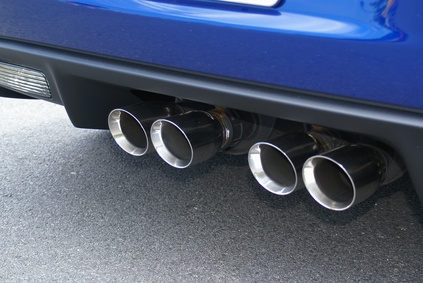
Several different engine issues may be present if your exhaust pipe is putting out black smoke. In a Toyota or any other make of car, black smoke is a key indicator that the fuel/air mixture is out of whack. All cars use a specific ratio of fuel and air in the combustion chamber; if the percentage of fuel rises beyond specifications, the mixture is too rich and black smoke is the result.
Check your air filter, which is a common source of a too-rich fuel/air ratio. Taking in dust, grit and smoke from the road, the filter can get clogged and lose its ability to pass an adequate supply of air into the carburetor and engine. Remove the air filter and, if it is dirty or full of grit and/or sand, throw it away.
Inspect the carburetor by removing the air filter, which rides on top of the carburetor. A small rectangular flap known as a choke plate is fixed longitudinally across the carburetor barrel; if this plate is firmly closed and can't be manipulated to open with a screwdriver or other tool, you have a stuck choke plate. The plate is not allowing adequate air into the carburetor and, as a result, your engine is running too rich. Try WD-40 or other spray lubricant on the choke plate to free it of gunk that may be affecting its movement. If the plate still won't move or is otherwise not opening and closing freely, have a mechanic replace it.
Bring your car to a reputable garage and have a mechanic inspect your fuel-injection system. Computer-controlled sensors are responsible for the fuel-injection operation; these sensors can malfunction or simply stop operating, requiring their replacement. The airflow sensor, throttle position sensor and coolant sensor all have a bearing on the fuel/air ratio burned in your engine's combustion chambers.
Ask your mechanic to inspect your vacuum regulator. Fuel is fed into the engine combustion chamber under pressure, which is controlled by this device. The regulator can malfunction and cause fuel pressure to rise beyond specified limits; the regulator can also rupture, allowing fuel into the vacuum line that directly feeds into the chamber. The mechanic will examine the vacuum feed line, test the system with a pressure gauge and check for the presence of fuel. The regulator may need to be replaced.
Run a pressure test on your vacuum line. You may have a vacuum leak, in which air is escaping from the combustion chambers or vacuum line, causing the engine to run too rich. Vacuum leaks can affect engine performance in other ways, and cannot be repaired in your own driveway. Have a mechanic run a vacuum test on your engine to determine if this is the source of the problem.